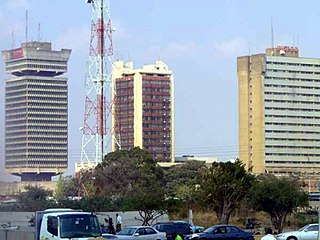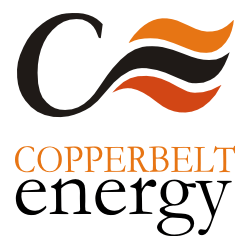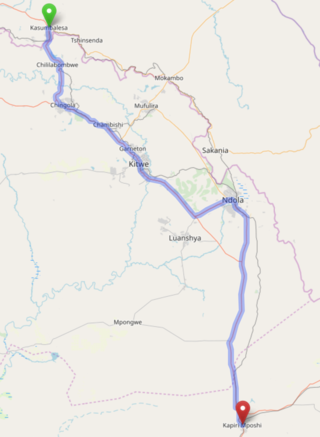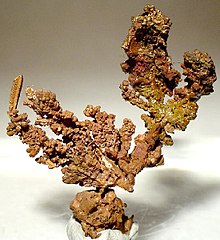
Zambia is a developing country, and it achieved middle-income status in 2011. Through the first decade of the 21st century, the economy of Zambia was one of the fastest-growing economies in Africa, and its capital, Lusaka, the fastest-growing city in the Southern African Development Community (SADC). Zambia's economic performance has stalled in recent years due to declining copper prices, significant fiscal deficits, and energy shortages.

Chingola is a city in Zambia's Copperbelt Province, the country's copper-mining region, with a population of 216,626. It is the home of Nchanga Copper Mine, a deep-shaft high-grade content copper mining operation, which subsequently led to the development of two open pit operations, Chingola Open Pit and then Nchanga Open Pit.

Ndola is the third largest city in Zambia and third in terms of size and population, with a population of 475,194, after the capital, Lusaka, and Kitwe, and the second largest in terms of infrastructure development after Lusaka. It is the industrial and commercial center of the Copperbelt, Zambia's copper-mining region, and capital of Copperbelt Province. It lies just 10 kilometres (6.2 mi) from the border with DR Congo. It is also home to Zambia's first modern stadium, the Levy Mwanawasa Stadium.

Kitwe is the third largest city in terms of infrastructure development and second largest city in terms of size and population in Zambia. With a population of 517,543 Kitwe is one of the most developed commercial and industrial areas in the nation, alongside Ndola and Lusaka. It has a complex of mines on its north-western and western edges.

Kabwe is the capital of the Zambian Central Province and the Kabwe District, with a population estimated at 202,914 at the 2010 census. Named Broken Hill until 1966, it was founded when lead and zinc deposits were discovered in 1902. Kabwe also has a claim to being the birthplace of Zambian politics as it was an important political centre during the colonial period.

The Copperbelt is a natural region in Central Africa which sits on the border region between northern Zambia and the southern Democratic Republic of Congo. It is known for copper mining.
Chililabombwe is a small town in Copperbelt Province, Zambia. It is located near the Democratic Republic of the Congo border. The name Chililabombwe means 'place of the croaking frog' in the local language of Lamba. The town has a population of 87 000 based on census data from 2010, making it one of the largest towns in the Copperbelt. The town is on the T3 road, 26 km north of the neighbouring town of Chingola, and approximately 10 km south of the large border market of Kasumbalesa. It has also produced national heroes like the late soccer star Eston Mulenga and many others.

Nkana FC is a football club based in Kitwe, Zambia. The football team competes in the MTN Super League, the top division of Zambian football. Nkana FC has won 13 League titles, making it Zambia's most successful league club, and second overall behind Mufulira Wanderers, with 52 trophies. They play their home games at Nkana Stadium in Wusakile, Kitwe.

ZCCM Investments Holdings is a successor company to Zambia Consolidated Copper Mines Limited, of Zambia.

Konkola Copper Mines is a copper mining and smelting company in Zambia. It is 80% owned by Vedanta Resources, a mining conglomerate based in Mumbai and London.

The following outline is provided as an overview of and topical guide to Zambia:

Mufulira Wanderers are Zambia's most successful football club, based in the Copperbelt town of Mufulira, currently competing in the Zambia Super League for the 2023–24 season after their promotion from the Zambia National Division One.
Mopani Copper Mines PLC is a Zambian company that produces and sells copper and cobalt to the international market, being one of the biggest mines and exporters in the world.
Kansanshi mine is a large copper and gold mine located in Solwezi in the North-Western Province of Zambia. The mine is approximately 14 kilometers north the town of Solwezi. Kansanshi is one of the largest copper reserves in Zambia, with estimated reserves of 727 million tonnes of ore graded at 0.86% copper.

Copperbelt Energy Corporation Plc (CEC) is a Zambian electricity generation, transmission, distribution and supply company with operations in Zambia and Nigeria. The company is listed on the Lusaka Stock Exchange
Chambishi is a town in Kalulushi District in the Copperbelt Province of Zambia. According to the 2021 Census its population stands at slightly above 11,000. It is located on the T3 road between the cities of Kitwe and Chingola.

The T3 is a Trunk Road in Zambia. The road runs from Kapiri Mposhi via Ndola, Kitwe and Chingola to Kasumbalesa on the border with DR Congo. The entire route is a toll road.
According to records from the RSSSF, there were many association football cup competitions organized in Zambia since 1962, some of which are the Independence Cup, the Zambian Challenge Cup, the Champion of Champions Cup and Zambian Coca-Cola Cup, the latter which began in 2001. These competitions are either inactive or were played no more as of 2009.














